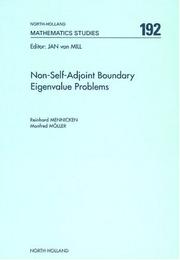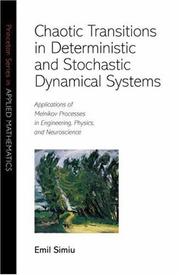| Listing 1 - 3 of 3 |
Sort by
|

ISBN: 9780444514479 0444514473 9780080537733 0080537731 1281048747 9781281048745 9786611048747 Year: 2003 Publisher: Amsterdam ; Boston : Elsevier,
Abstract | Keywords | Export | Availability | Bookmark
 Loading...
Loading...Choose an application
- Reference Manager
- EndNote
- RefWorks (Direct export to RefWorks)
This monograph provides a comprehensive treatment of expansion theorems for regular systems of first order differential equations and n-th order ordinary differential equations.In 10 chapters and one appendix, it provides a comprehensive treatment from abstract foundations to applications in physics and engineering. The focus is on non-self-adjoint problems. Bounded operators are associated to these problems, and Chapter 1 provides an in depth investigation of eigenfunctions and associated functions for bounded Fredholm valued operators in Banach spaces. Since every n-th orde
Boundary value problems. --- Nonselfadjoint operators. --- Eigenvalues. --- Differential equations.

ISBN: 9781400832507 9780691144344 1400832500 9780691050942 0691050945 0691144346 Year: 2002 Publisher: Princeton, New Jersey : Princeton University Press,
Abstract | Keywords | Export | Availability | Bookmark
 Loading...
Loading...Choose an application
- Reference Manager
- EndNote
- RefWorks (Direct export to RefWorks)
The classical Melnikov method provides information on the behavior of deterministic planar systems that may exhibit transitions, i.e. escapes from and captures into preferred regions of phase space. This book develops a unified treatment of deterministic and stochastic systems that extends the applicability of the Melnikov method to physically realizable stochastic planar systems with additive, state-dependent, white, colored, or dichotomous noise. The extended Melnikov method yields the novel result that motions with transitions are chaotic regardless of whether the excitation is deterministic or stochastic. It explains the role in the occurrence of transitions of the characteristics of the system and its deterministic or stochastic excitation, and is a powerful modeling and identification tool. The book is designed primarily for readers interested in applications. The level of preparation required corresponds to the equivalent of a first-year graduate course in applied mathematics. No previous exposure to dynamical systems theory or the theory of stochastic processes is required. The theoretical prerequisites and developments are presented in the first part of the book. The second part of the book is devoted to applications, ranging from physics to mechanical engineering, naval architecture, oceanography, nonlinear control, stochastic resonance, and neurophysiology.
Mathematics --- Differentiable dynamical systems. --- Chaotic behavior in systems. --- Stochastic systems. --- Affine transformation. --- Amplitude. --- Arbitrarily large. --- Attractor. --- Autocovariance. --- Big O notation. --- Central limit theorem. --- Change of variables. --- Chaos theory. --- Coefficient of variation. --- Compound Probability. --- Computational problem. --- Control theory. --- Convolution. --- Coriolis force. --- Correlation coefficient. --- Covariance function. --- Cross-covariance. --- Cumulative distribution function. --- Cutoff frequency. --- Deformation (mechanics). --- Derivative. --- Deterministic system. --- Diagram (category theory). --- Diffeomorphism. --- Differential equation. --- Dirac delta function. --- Discriminant. --- Dissipation. --- Dissipative system. --- Dynamical system. --- Eigenvalues and eigenvectors. --- Equations of motion. --- Even and odd functions. --- Excitation (magnetic). --- Exponential decay. --- Extreme value theory. --- Flow velocity. --- Fluid dynamics. --- Forcing (recursion theory). --- Fourier series. --- Fourier transform. --- Fractal dimension. --- Frequency domain. --- Gaussian noise. --- Gaussian process. --- Harmonic analysis. --- Harmonic function. --- Heteroclinic orbit. --- Homeomorphism. --- Homoclinic orbit. --- Hyperbolic point. --- Inference. --- Initial condition. --- Instability. --- Integrable system. --- Invariant manifold. --- Iteration. --- Joint probability distribution. --- LTI system theory. --- Limit cycle. --- Linear differential equation. --- Logistic map. --- Marginal distribution. --- Moduli (physics). --- Multiplicative noise. --- Noise (electronics). --- Nonlinear control. --- Nonlinear system. --- Ornstein–Uhlenbeck process. --- Oscillation. --- Parameter space. --- Parameter. --- Partial differential equation. --- Perturbation function. --- Phase plane. --- Phase space. --- Poisson distribution. --- Probability density function. --- Probability distribution. --- Probability theory. --- Probability. --- Production–possibility frontier. --- Relative velocity. --- Scale factor. --- Shear stress. --- Spectral density. --- Spectral gap. --- Standard deviation. --- Stochastic process. --- Stochastic resonance. --- Stochastic. --- Stream function. --- Surface stress. --- Symbolic dynamics. --- The Signal and the Noise. --- Topological conjugacy. --- Transfer function. --- Variance. --- Vorticity.
Multi
ISBN: 9781400835355 9780691140612 1282979108 9786612979101 1400835356 9781282979109 Year: 2010 Publisher: Princeton : Princeton University Press,
Abstract | Keywords | Export | Availability | Bookmark
 Loading...
Loading...Choose an application
- Reference Manager
- EndNote
- RefWorks (Direct export to RefWorks)
This accessible book provides an introduction to the analysis and design of dynamic multiagent networks. Such networks are of great interest in a wide range of areas in science and engineering, including: mobile sensor networks, distributed robotics such as formation flying and swarming, quantum networks, networked economics, biological synchronization, and social networks. Focusing on graph theoretic methods for the analysis and synthesis of dynamic multiagent networks, the book presents a powerful new formalism and set of tools for networked systems. The book's three sections look at foundations, multiagent networks, and networks as systems. The authors give an overview of important ideas from graph theory, followed by a detailed account of the agreement protocol and its various extensions, including the behavior of the protocol over undirected, directed, switching, and random networks. They cover topics such as formation control, coverage, distributed estimation, social networks, and games over networks. And they explore intriguing aspects of viewing networks as systems, by making these networks amenable to control-theoretic analysis and automatic synthesis, by monitoring their dynamic evolution, and by examining higher-order interaction models in terms of simplicial complexes and their applications. The book will interest graduate students working in systems and control, as well as in computer science and robotics. It will be a standard reference for researchers seeking a self-contained account of system-theoretic aspects of multiagent networks and their wide-ranging applications. This book has been adopted as a textbook at the following universities: ? University of Stuttgart, Germany Royal Institute of Technology, Sweden Johannes Kepler University, Austria Georgia Tech, USA University of Washington, USA Ohio University, USA
Mathematics --- Network analysis (Planning) --- Multiagent systems --- Graphic methods. --- Mathematical models. --- Addition. --- Adjacency matrix. --- Algebraic graph theory. --- Algorithm. --- Automorphism. --- Bipartite graph. --- Cardinality. --- Cartesian product. --- Circulant graph. --- Combinatorics. --- Complete graph. --- Computation. --- Connectivity (graph theory). --- Controllability. --- Convex combination. --- Corollary. --- Cycle graph (algebra). --- Cycle space. --- Degree (graph theory). --- Degree matrix. --- Diagonal matrix. --- Diameter. --- Differentiable function. --- Dimension. --- Directed graph. --- Division by zero. --- Dynamical system. --- Eigenvalues and eigenvectors. --- Equilibrium point. --- Estimation. --- Estimator. --- Existential quantification. --- Extremal graph theory. --- Graph (discrete mathematics). --- Graph theory. --- Identity matrix. --- Incidence matrix. --- Information exchange. --- Initial condition. --- Interconnection. --- Iteration. --- Kalman filter. --- Kronecker product. --- LTI system theory. --- LaSalle's invariance principle. --- Laplacian matrix. --- Least squares. --- Line graph. --- Linear map. --- Lipschitz continuity. --- Lyapunov function. --- Lyapunov stability. --- Markov chain. --- Mathematical optimization. --- Matrix exponential. --- Measurement. --- Multi-agent system. --- Nash equilibrium. --- Natural number. --- Network topology. --- Nonnegative matrix. --- Notation. --- Observability. --- Optimal control. --- Optimization problem. --- Pairwise. --- Parameter. --- Path graph. --- Permutation matrix. --- Permutation. --- Positive semidefinite. --- Positive-definite matrix. --- Probability. --- Quantity. --- Random graph. --- Random variable. --- Rate of convergence. --- Requirement. --- Result. --- Robotics. --- Scientific notation. --- Sensor. --- Sign (mathematics). --- Simplicial complex. --- Special case. --- Spectral graph theory. --- Stochastic matrix. --- Strongly connected component. --- Subset. --- Summation. --- Supergraph. --- Symmetric matrix. --- Systems theory. --- Theorem. --- Theory. --- Unit interval. --- Upper and lower bounds. --- Variable (mathematics). --- Vector space. --- Without loss of generality.
| Listing 1 - 3 of 3 |
Sort by
|

 Search
Search Feedback
Feedback About UniCat
About UniCat  Help
Help News
News